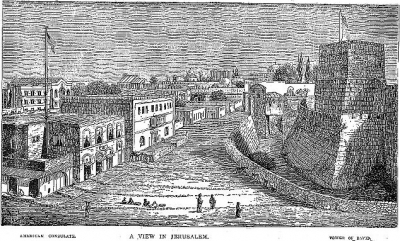 Illustration from JW McGarvey, "Lands of the Bible" (1881). The American consulate is on the left side. |
|
The U.S. Consulate in Jerusalem has a storied history, going back to 1844, when it was established to function as a sort of "tourist agency" that helped plan trips for traveling Americans.
In recent years, however, things have become less quaint. In particular, since World War I, there have been two consulates, one in the eastern and predominantly Arab part of the city and one in the western, or Jewish area. Although both are now in lands under Israeli control, an Arab/Israeli divide remains in place, with perhaps political overtones. A reader reports on the situation these days:
The two U.S. consulates in Jerusalem could not be more different. The one in a Jewish neighborhood has ample parking facilities but does not provide consular services and so does not deal with the public. The one in an Arab neighborhood provides those services but has no parking available nearby. Ironically, of the tens of thousands of U.S. citizens who live in Jerusalem and surrounding communities, nearly all are Jews. This means that any citizens needing to renew a passport, report a birth, deal with Social Security, etc. must go there, at least part of the way on foot. Also, despite the fact that most American citizens in the Jerusalem area are Orthodox Jews with large families, no strollers are allowed. Babies and toddlers must be carried.
As far as one can see, nearly the entire staff at the consulate dealing with the public are Arabs, including the security guards, clerks, ushers, cashiers, et al. The only reading material available in the waiting area is the State Dept's, Hi International magazine - in Arabic, of course. The whole set-up feels like a slap in the face to the American citizens it is meant to serve.
And this: U.S. missions are mandated to display a listing of the "Most Wanted Terrorists," which consists of about 25 FBI flyers and photos of Islamists, all Arab. How embarrassing – so where in the eastern Jerusalem consulate does this display turn up? In a dark and narrow hallway, at the bottom of a stairwell, that leads only to the exit, making it noticeable only to an observant passer-by.
Given the known historic predilection of the eastern Jerusalem consulate for the Palestinians, none of this comes as a shock. But when will adult supervision come to that sensitive mission? (December 29, 2005)
Feb. 28, 2013 update: Naomi Ragen provides an update and a case study about the misfit consulate today in the Jerusalem Post. She reports that the consulate has moved to Arnona in the western part of the city but despite that, things remain "pretty much the same," which is to say, unpleasant for Jews seeking services. Excerpts:
A quick look at the cultural activities on the consulate's website and its Arabic language Facebook page shows activities exclusively aimed at benefiting West Bank and east Jerusalem Palestinians, whether the focus is women's rights or small businesses. Even Environment Day had the consul going to Wadi Kelt "to observe local flora and fauna in one of the West Bank's most vibrant natural habitats." As for local hires, almost all job descriptions require Arabic.
Ragen then tells the story of Eliana M. Aaron, "one of the very few Orthodox Jewish American Consulate employees." To make a long story short, Aaron was hounded and hassled in her work, to the point that she first filed a complaint with the Equal Employment Opportunity Commission and then filed a lawsuit against the consulate in the Jerusalem Labor Court.
